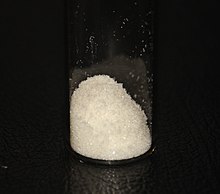 | |
 | |
| Names | |
|---|---|
| Preferred IUPAC name 1,10-Phenanthroline [1] | |
| Identifiers | |
3D model (JSmol) |
|
| 126461 | |
| ChEBI | |
| ChEMBL |
|
| ChemSpider | |
| DrugBank | |
| ECHA InfoCard | 100.000.572 |
| EC Number |
|
| 4040 | |
| KEGG | |
PubChem CID | |
| RTECS number |
|
| UNII |
|
| UN number | 2811 |
CompTox Dashboard (EPA) | |
| |
| |
| Properties | |
| C12H8N2 | |
| Molar mass | 180.21 g/mol |
| Appearance | colourless crystals |
| Density | 1.31 g/cm3 |
| Melting point | 118.56 °C (245.41 °F; 391.71 K) [2] |
| Boiling point | 409.2 [2] |
| high [2] | |
| Solubility in other solvents | acetone, ethanol [2] |
| Acidity (pKa) | 4.84 (phenH+) [2] |
| Hazards | |
| Occupational safety and health (OHS/OSH): | |
Main hazards | mild neurotoxin, strong nephrotoxin, and powerful diuretic |
| GHS labelling: | |
  | |
| Danger | |
| H301, H410 | |
| P264, P270, P273, P301+P310, P321, P330, P391, P405, P501 | |
| Related compounds | |
Related compounds | 2,2'-bipyridine ferroin phenanthrene |
Except where otherwise noted, data are given for materials in their standard state (at 25 °C [77 °F], 100 kPa). | |
1,10-Phenanthroline (phen) is a heterocyclic organic compound. It is a white solid that is soluble in organic solvents. The 1,10 refers to the location of the nitrogen atoms that replace CH's in the hydrocarbon called phenanthrene.
Contents
Abbreviated "phen", or sometimes "o-phen" for ortho-phenanthroline, it is used as a ligand in coordination chemistry, forming strong complexes with most metal ions. [3] [4] It is often sold as the monohydrate.